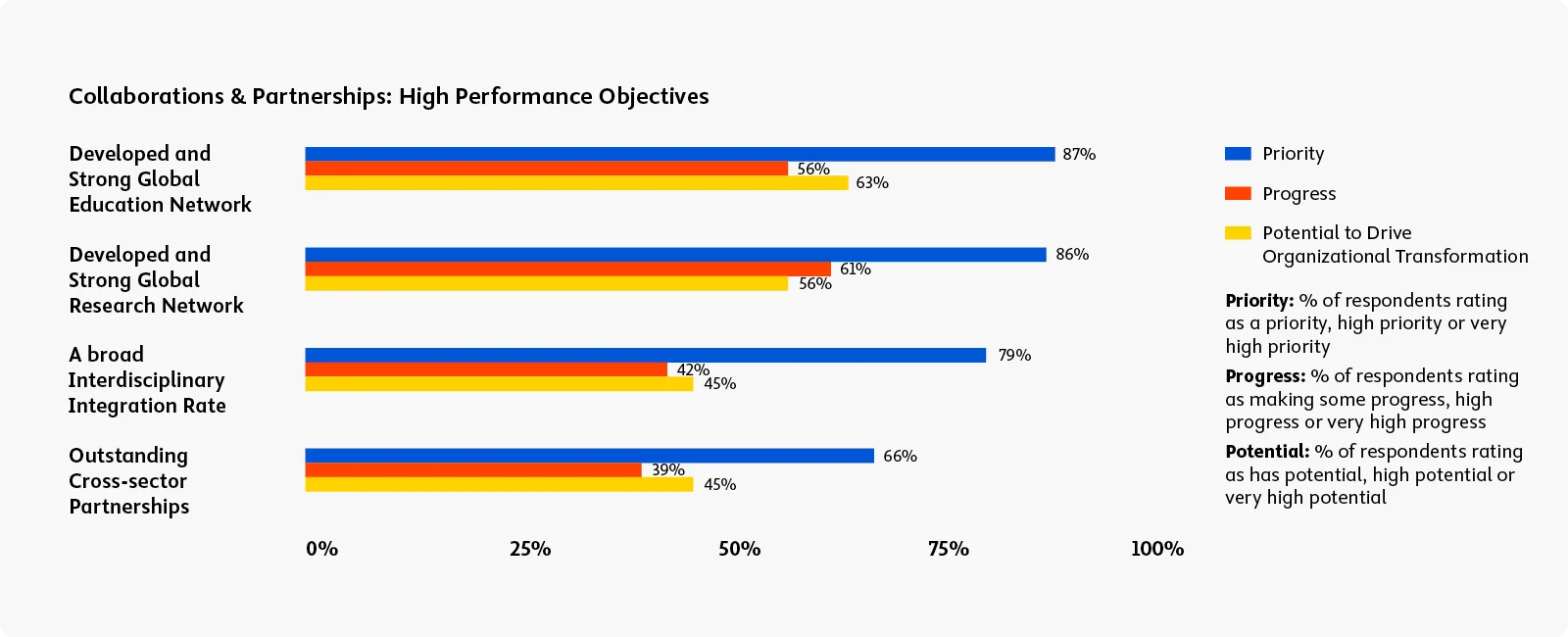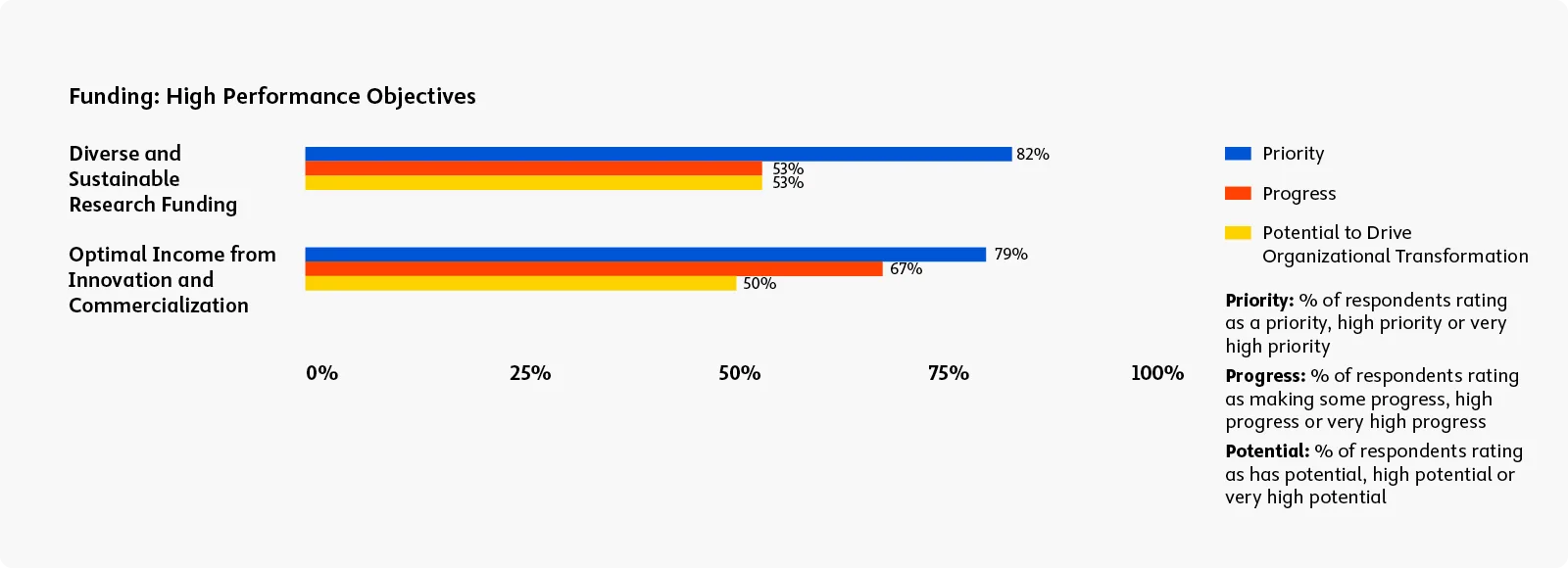Opportunities: How rethinking strategic partnerships can help close your revenue gap
Why accessing a more diverse mix of funding is crucial in today’s hyper-competitive environment.

Raising funding is a persistent challenge for universities, yet institutions must proactively develop strong and diverse opportunity pipelines to build greater financial resilience for the future. This includes finding alternative or new funding opportunities to diversify revenue sources, build financial resilience and give universities a greater chance of generating the funds they need.
A finite amount of research funding is available to bid for, making every round highly competitive, meaning that financing is not available for all potentially groundbreaking research. However, identifying and accessing more diverse funding sources is not straightforward. Charitable and industry funding will likely be in high demand, meaning bids will be just as competitive as the government grant process. Participating in open innovation agreements may come with expectations about ownership of IP and publication embargoes.
In this hyper-competitive environment, institutions increasingly recognize the need to broaden their global networks and build partnerships with other institutions and corporations to increase their chances of funding success and revenue generation. Data-powered insights can help with this process by enabling institutions to identify experts across research fields, sectors and geographies, see who has been successful with past funding bids, or identify which organizations are funding research that aligns with their strategic goals and primary research areas.
Strategic partnerships can lead to an exchange of ideas across geographies and sectors. They can also help develop revenue diversity by expanding institutional influence and reputation worldwide and opening up opportunities for international funding bids or network grants. Strategic partnerships can also give students unique opportunities to learn and expand their skill sets, making them more employable as graduates.
Our High Performance Objectives research highlights the key priorities of academic leaders when it comes to strategy, comparing their progress in achieving these goals, and exploring the transformative potential of successfully delivering on them.


To learn more, read our report
Plan for progress
Explore revenue diversity to support institutional sustainability
Institutions are looking at diversifying their revenue sources, not just maximizing revenue, in a more uncertain economic environment.
In our research, 81% of academic leaders said effective revenue diversity is a priority.
Building resilience means moving beyond funding avenues, such as government grants and student fees, to tap a broader revenue mix, including industry and charities.
Globally, there are many different financial models for universities, which are often linked to their relationships with the government and the private sector. In the UK, for example, there are traditionally two dominant sources of research funding: block grants or research council grants. Since success rates for traditional non-block grants are between one in four and one in five, institutions need to diversify their revenue sources away from this limited pot. By going beyond traditional sources, institutions can improve their chances of securing funding and increase their resilience.
Finding fresh funding opportunities
Given the vast pool of potential funding and revenue sources and the hyper-competitive environment, technology and data can help universities gain a competitive edge (see box out). For instance, data and technology can help uncover companies providing funding for an emerging area of research and with whom they also currently have active partnerships. With significant pressures on their time, intense competition and low success rates, academic staff must decide which opportunities offer the best chance of success.
Most funding bodies place administrative and financial obligations on awardees, such as reporting requirements. They may require adherence to open access mandates, where non-compliance can lead to loss of future funding. Technology can also help support grant compliance and reporting requirements and demonstrate impact and return on investment for funders.

Strategies for unlocking research funding
Given the amount of effort required to write a grant application, there are strategies that teams and institutions can employ to improve their success rates. One way is through expanding existing collaborations, as established relationships can help reduce perceived risks for funding bodies. Another way is to explore new partnerships on and beyond campus, across sectors or even internationally, to help tap into new expertise in related or aligned fields.
Demonstrating and evidencing the team’s expertise through prior outputs and impact can also help show a funding body that your institution has the necessary capabilities to achieve what it is proposing in a funding bid. Software tools, data and technology can help across all these areas, providing institutions and their teams with insights to help maximize their chances of success.

Using tools for funding success
Technology has become essential to institutions’ pre- and post-award management lifecycle, from helping uncover open funding opportunities to managing approval workflows and post-award compliance and reporting. Academics will likely know the most prominent funding bodies in their field. However, they may not be aware of smaller funding bodies or those in different fields where there might be interdisciplinary partnership opportunities. Using data and technology can help academics find opportunities that they may have missed otherwise, ensuring their valuable time is spent on the bids with the highest chance of success.
Expand your capabilities and influence through global networks
The second area that can help maximize funding success rates is growing partnerships internationally and across sectors.
In our research, 56% of academic leaders believed developed and strong global networks to be a transformation objective.
These networks can help expand capacity and capability, for example, by gaining access to state-of-the-art facilities or funding from a new corporate partner. Such partnerships can bring leading experts together to harness combined strengths, potentially generating more financing and resulting in a greater impact — all of which can help extend an institution’s reach and bolster its reputation.
Most institutions have a variety of networks across areas such as teaching, research, culture and industry. These networks are interlinked and can provide opportunities to expand and deepen each other, drawing upon existing connections for the benefit of both parties. For instance, institutions may turn to their existing teaching partners to initiate research partnerships. If institutions already have those relationships, they could consider building on those first.
In addition to international and cross-sector partnerships, there are other opportunities, such as partnering with local governments and the local innovation ecosystem.
Identifying outstanding collaboration opportunities
Using software that draws on advanced technology and authoritative data can help institutions understand the unique strengths of both their teams and potential partners across geographies and sectors. This ensures mutual benefit for all parties. For example, an industry collaboration could bring leading academic and industry experts together to harness their combined strengths, accelerating the translation of discoveries and developments into real-world outcomes and impact. It also enables partners to access the latest facilities or help the corporate partner address an R&D challenge they cannot solve in-house.
Furthermore, institutions could expand an industry partnership to include internships, allowing students to gain valuable workplace experience and build transferable skills to improve employment prospects. Such a program could also boost the institution’s reputation for excellent graduate outcomes.

How Elsevier can help
Supporting revenue goals
Finding new funding opportunities, maintaining grant compliance and demonstrating successful research outcomes are all time-consuming activities that can benefit from technology investment. Elsevier’s SciVal platform, for example, gives research teams insights into the funding landscape, indicating what research has been funded and highlighting active opportunities. Research teams can also strategically plan their bids by assessing the credentials of other potential bidders and identifying partnership opportunities that could increase the chances of funding success. For instance, an institution might be able to provide a more compelling proposal by partnering with other institutions that elevate their collective capabilities. Elsevier’s Funding Institutional allows users to search over 40,000 active funding opportunities with information on over 8 million awarded grants.
Elsevier’s Pure can help with award management and compliance, including impact reporting. For example, the Pure Award Management module can help institutions manage their workflow from proposal development to project completion. At the same time, the Pure Portal enables universities to showcase their expertise and accomplishments, facilitate collaboration and, most importantly, grow their reputation for excellence.
Facilitating global collaboration
Seeking collaborations is an increasingly important strategy for academic leaders wanting to achieve sustained high performance, whether through tie-ups with other institutions for teaching, research partnerships or working with commercial enterprises on applied research projects. Senior leadership, in particular, must cultivate these relationships to be sustained even if individual faculty members or their teams move on to other institutions.
Elsevier’s SciVal platform helps academic leaders better identify and conduct due diligence on potential partners by analyzing their research performance or past funding success. Additionally, Scopus® provides detailed profiles of individual researchers and their outputs across their awarded grants, who is citing their work and any preprints as an indication of current focus. Scopus AI also helps institutions identify experts across different research fields who are competitors or potential partners.
Interested in solutions for harnessing institutional opportunities? Learn how Elsevier’s Research Intelligence portfolio can help your institution identify and capitalize on the research, funding and collaboration opportunities that level up your institution's performance.
Browse our solutions for funding and collaboration opportunities or contact us to discuss your needs.